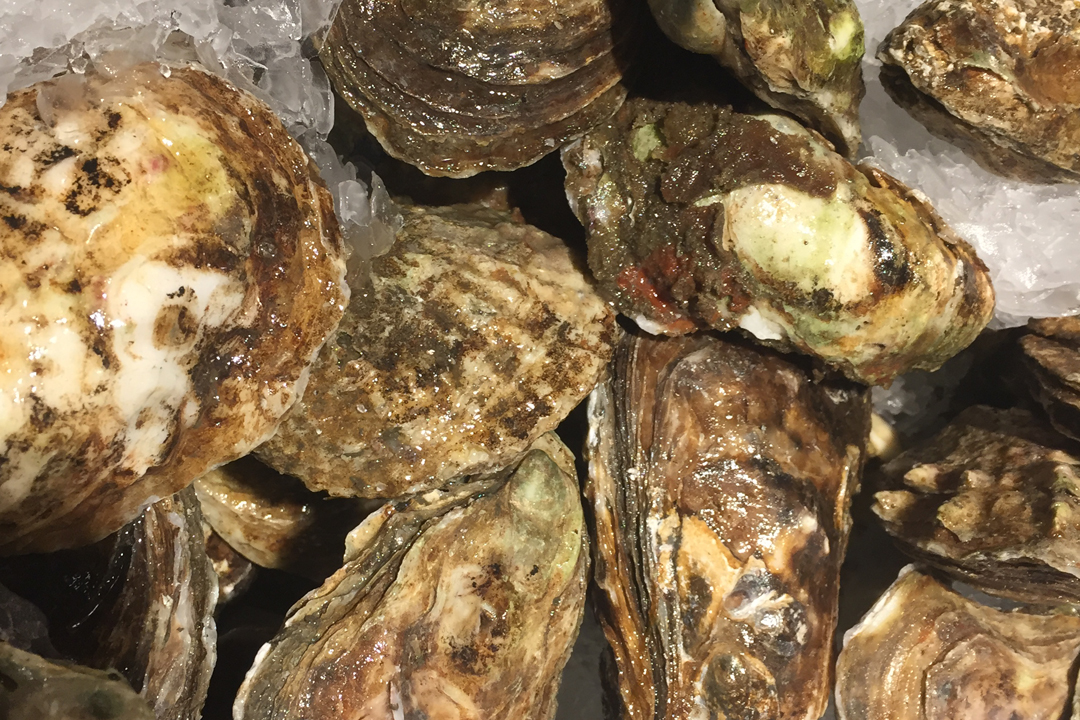
Reducing Food Waste in Foodservice
October 16, 2018 by Doreen Garelick, Dietetic Intern
Our intern Doreen attended a food waste summit for restaurants and compiled these tips to help food service operators redirect…
September 20, 2016

Growing up, my dad and uncle were always on the prowl for $1 oyster happy hours, typically $3 a piece, so anytime I see it on the chalkboard outside of a restaurant it makes me really happy. And I don’t even like them that much.
Labor Day weekend, wandering around the West Village, I sat down to an oyster happy hour. After already eating three, I reached for the fourth and saw something very strange. No, not a pearl! It was bigger and had legs. I immediately felt queasy and couldn’t eat another.
I pulled out my phone and learned my happy hour guest was an Oyster Crabs. Considered a "Chesapeake delicacy” and even lucky, these are most commonly found in oysters of the Atlantic Ocean. About the size of a penny, they have soft shells and use the oyster for protection, stealing all of its food in the meantime. It was translucent, slimy, crunchy and kind of burst in your mouth, but also a little sweet and salty. Like oysters, coffee, olives or blue cheese, I would definitely consider it an acquired taste.
Add Oyster Crab to the list of interesting facts about oysters. Oysters are bivalve mollusks and can be eaten a number of ways-roasted, steamed, broiled, poached, grilled, baked, fried, marinated, stuffed, and especially raw. Cooked or raw, oysters can be part of both a sustainable and healthy meal.
Every 6 raw oysters have about 150 calories and contain a long list of vitamins and minerals with zinc, iron, vitamin B12 and selenium being some of the most prominent. Furthermore, the nutrients they provide may reduce blood pressure, increase energy levels, improve immune function, increase tissue repair and growth, increase bone strength and may even work as a powerful aphrodisiac.
In addition to being good for us, oysters can also help the ocean environment. One oyster filters up to 50 gallons of water through its gills, eating algae, removing dirt and consuming nitrogen in the process. While nitrogen isn't itself toxic, excess nitrogen is harmful to aquatic ecosystems as it promotes excessive algae growth. Once the algae falls to the bottom and begins to decay, that decaying process removes oxygen from the water.
Since the Civil War and the popularity of canning, the oyster population has been in decline. Due to overfishing, disease and habitat loss, the acreage of oyster reefs has dropped 80%. As oceans warm, animal life must move farther north, in search of colder and cleaner water. The warmer water has also led to an increase in the bacteria Vibrio, which can cause uncomfortable GI symptoms and could be dangerous to those with open wounds of any kind.
Overcoming disease and restoring oyster beds can be difficult because it has a lot to do with weather conditions and water temperature. But there are strategies in place to restore the oysters’ ecosystem. For example, in Maryland and Virginia, oyster management plans include limiting the amount of oysters removed each year, establishing a safe and disease free habitat for them, and restoring reefs by building, seeding and monitoring oyster populations on a long-term basis.
Test your oyster knowledge!
Fact or Myth? Oysters are poisonous during the months without the letter “R” (May-August).
Myth! Today it is safe and easy to consume oysters year round...oysters can be properly chilled and oyster farming has made easier avoid having to ship product across the country. This myth originated in the mid-19th century from the higher bacteria content and chance of disease related to improperly shipping and handling of oysters in the warmer months. These 4 also make up the reproductive season, so the flesh is often too thin and watery for sale.
Fact or Myth? Oysters are an aphrodisiac.
Somewhat true. This association likely came about because oysters are very high in zinc which is important to sexual development and health and low levels of zinc have been linked to impotence and delayed sexual development.
Fact or Myth? Oysters aren’t as scary and dangerous as they seem.
Fact! If oysters are caught and shipped from a reliable source, and kept cold, they should be just fine to eat. If you have a previous severe illness, such as liver disease, inflammatory bowel disease or achlorhydria (absence of stomach acid) I would be careful, and of course, random accidents could happen. If you are trying raw oysters from a restaurant, ask about their sources and do research on the ways they prevent foodborne illnesses from spreading.

October 16, 2018 by Doreen Garelick, Dietetic Intern
Our intern Doreen attended a food waste summit for restaurants and compiled these tips to help food service operators redirect food waste from landfills.
Nutrition 101

Nutrition 101
September 26, 2018 by Doreen Garelick, Dietetic Intern
Ever notice headlines about rapid weightloss? Dietetic Intern Doreen Garelick looks deeper into a recent eye-catching headline to see if there's any truth behind it.
Connect
 Follow us on Twitter
Follow us on Twitter Friend us on Facebook
Friend us on Facebook Follow us on Pinterest
Follow us on Pinterest Follow us on Instagram
Follow us on Instagram Read our Blog
Read our Blog Watch videos on YouTube
Watch videos on YouTube Watch videos on Vimeo
Watch videos on Vimeo Connect with us on Linkedin
Connect with us on Linkedin Find us on Foursquare
Find us on Foursquare
Tweets by @SPEcertifiedBlog Search
Categories
SPE Certified Newsletter
Sign up for news on the latest SPE-certified venues, events and SPE updates.
We will never share your personal information with a third party.